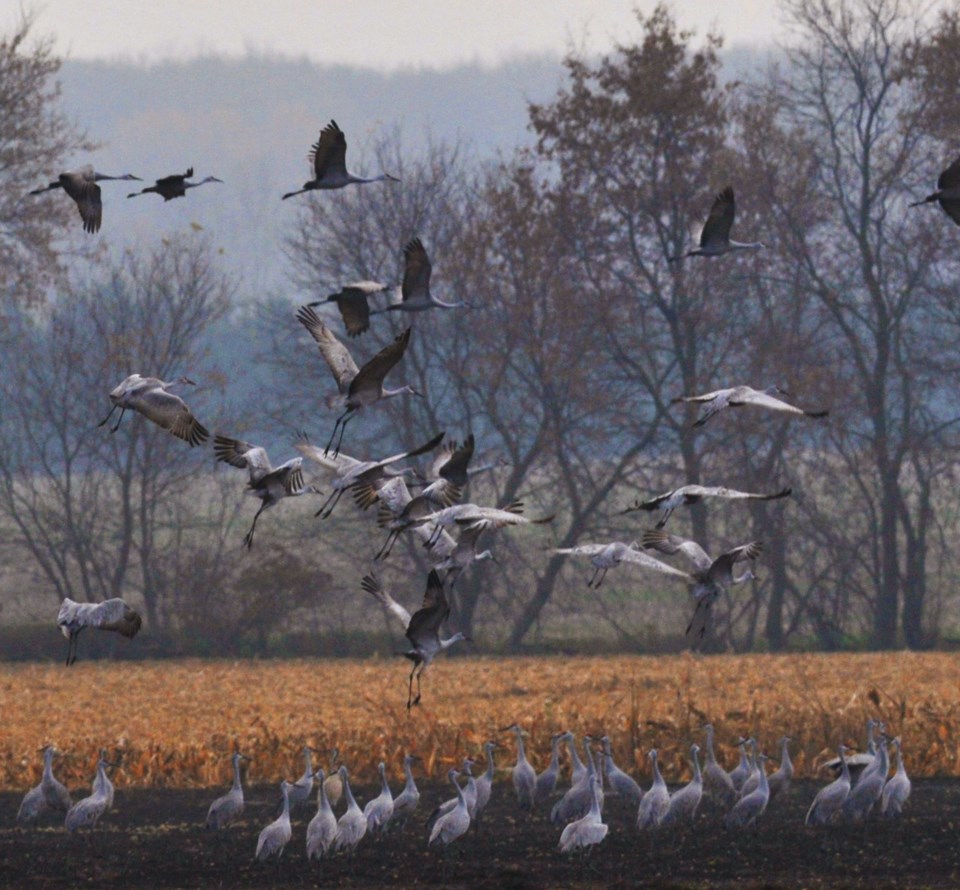As a nature-loving kind of guy, I like to think that a report of a species strengthening its population is a good thing.
So often the story is that of the other 'direction', in that one species after another is dwindling to a point of possible extinction.
And so it was bit of a surprise when I flipped open a recent Ontario Farmer newspaper (yes, a real newspaper that can be flipped open and propped up against a cereal box on the kitchen table) and saw an article bemoaning the sandhill crane.
Sandhill cranes are large birds, an adult being a metre and half high (about chest height). They consist of a lot of leg length, a very wide wing spread, as much neck as leg, and a formidably long dagger-like beak. Holding all this stuff in place is a body about the size of a Canada goose.
However gangly they may sound, watching a crane walk about is a package of grace and elegance.
For decades, local birdwatchers have always been on the lookout for a migrating sandhill crane to do a fly-past of Simcoe County.
Their appearance in this area had been a noteworthy event, and novice ornithologists were tested on their observation skills when asked if the neck was outstretched or curled up when flying.
Great blue herons are about the same size but tend to curl their neck in a S-shape when flying, and when thus observed shattered any hope of calling in a report of a crane.
But something is going on out there. Over the past ten years or so this species has shown a remarkable increase in its presence.
A few showed up at Tiny Marsh (even doing their weird jumping up and about mating dance), then the Coldwater area had small flocks of a dozen or so dropping in. Fast forward to last year and the sandhill crane migration through Simcoe County hit about 8,000 birds! Whaaaat? Yeah, like what is going on?
I don't know (sorry if that disappoints you) but something is in play to have such an increase in a bird species that ranged from rare to uncommon only a short while ago.
Have they shifted their migration route from the central flyway of Saskatchewan and the Dakotas, to the Mississippi flyway that touches on the west side of the Great Lakes? Has their population just plain shot up?
Back to that article in the Ontario Farmer ... apparently the flocks of sandhill cranes are so huge (numbering up to 14,000 birds) entire crop fields are being wiped out with just one visit from these long-legged birdies.
Spring migration means some farmers have to re-plant as the original seeding has been pulled up for crane re-fuelling.
Fall migration is devastating potato crops as some potatoes are scratched up and exposed to frost, which when mixed in with good potatoes that are later harvested from deep in the soil results in the whole crop being contaminated and rotting. That's a real problem.
As one of the affected farmers said in the article, "he finds it hard to believe they once appreciated the novelty of the birds as they landed at his farm". But now the birds are seen as "the enemy" and efforts are underway to thwart the appetite of hungry cranes.
Corn that tastes bad is one option, but apparently massive flocks of Canada geese (also a crop-stealing bird) are not fazed by the odd flavour. So where did all these birds come from?
A similar situation is developing with other bird species such as the double-crested cormorants, wild turkeys, Canada geese, greater black-backed gulls, and trumpeter swans.
Some were 're-introduced' to the wilds of Ontario, while others have always been out there but, until recently, in low numbers.
The surge in wild turkeys has all but wiped out salamanders on my farm, as the fallen leaves that are raked back by hungry turkeys are the leaves that for years upon years have afforded protection to a local population of red-backed salamanders. Not anymore.
While lingering populations of loggerhead shrikes and barn swallows take a nose-dive, why is it that these others species are thriving? Unfortunately there is no short and easy answer.
Some species are adapting to warmer winters (not this winter!), some are altering their migration routes (perhaps due to crop changes on the landscape), some are just having a good ride for now with abundant food for successful rearing of young.
Research has to be done to better track these and other species, to follow them year-round to see where they go for food, for shelter, for mating, for rearing vulnerable young.
Technology is providing ways to now attach lightweight yet strong transmitters to birds, their flight paths being recorded as 'pings' on receiving towers in both Canada and United States.
A recent study of nighthawks clearly revealed the migration pathways between their summer breeding grounds in Canada to the wintering grounds of a Brazilian forest.
And the birds returned the following year to the exact spot they started.
Without a diffusion of birds to a variety of nesting spots, it shows that if a nesting area is destroyed it can wipe out a whole segment of over wintering birds.
Grains of sand... bits of knowledge.
I think I will still marvel at a loudly calling sandhill crane as it flies over, and will be amazed at the resiliency of a flock of wild turkeys when they show up at 20 degrees below freezing; but will balance that sighting with compassion that others may not be enjoying these critters to the same extent.



